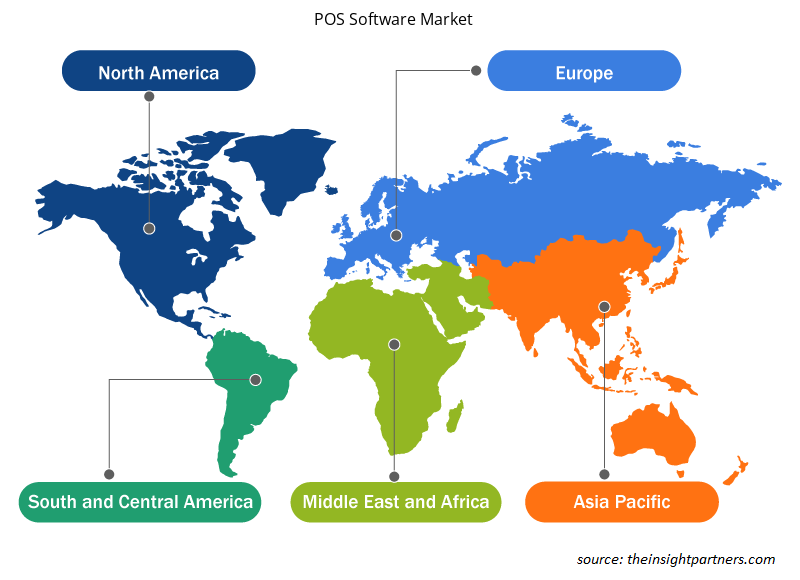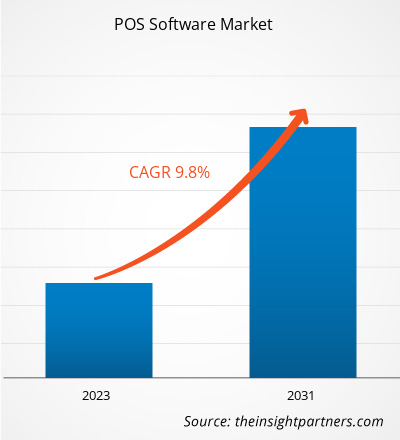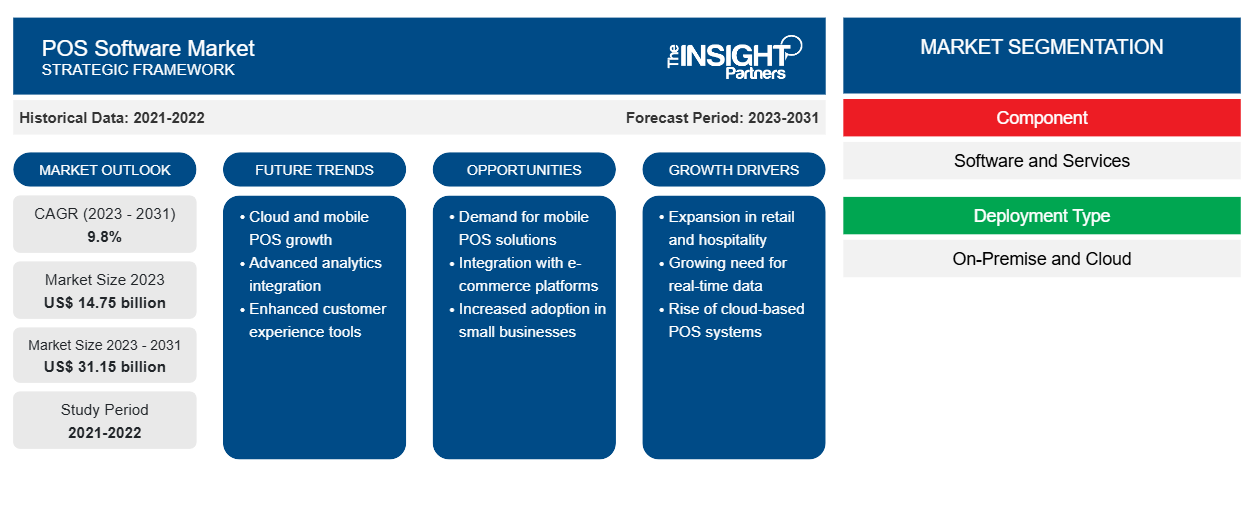POS 소프트웨어 시장 규모는 2023년 147억 5천만 달러에서 2031년 311억 5천만 달러로 성장할 것으로 예상됩니다. 이 시장은 2023년부터 2031년까지 9.8%의 CAGR을 기록할 것으로 예상됩니다. 클라우드 컴퓨팅 서비스 사용 증가는 POS 소프트웨어 시장의 주요 추세로 남을 가능성이 높습니다.
POS 소프트웨어 시장 분석
현금 없는 거래를 수행하고, 판매 및 재고 데이터를 추적하고, 분석을 활용하여 리테일 체인점, 레스토랑, 호텔, 약국, 자동차 수리점 및 기타 장소에서 판매 전략을 최적화해야 하는 필요성으로 인해 POS(판매 시점) 소프트웨어에 대한 수요가 증가했습니다. 고객 데이터 관리, 재고 추적, 판매 모니터링, 직원 관리 분석 및 보고를 포함한 고급 기능에 대한 수요가 증가함에 따라 다양한 산업에서 POS 소프트웨어 사용이 증가할 것으로 예상됩니다. 또한 클라우드 기반 모바일 POS 소프트웨어에 대한 수요가 증가하는 것은 클라우드 기반 솔루션에 대한 수용이 증가하고 있기 때문일 수 있습니다.
POS 소프트웨어 시장 개요
POS(Point-of-Sale) 소프트웨어는 기업이 일반적으로 소매점에서 판매 시점에 거래를 수행하는 데 사용하는 특수 애플리케이션입니다. 판매를 추적하고, 재고를 관리하고, 지불을 처리함으로써 체크아웃 프로세스를 신속하게 처리합니다. 정확성을 보장하기 위해 POS 소프트웨어는 바코드 스캐너 , 금전 등록기, 카드 리더기와 같은 하드웨어와 자주 인터페이스합니다. 또한 고객 정보를 처리하고, 판매 보고서를 작성하고, 평가하기 위한 도구가 있습니다.
귀하의 요구 사항에 맞게 이 보고서를 사용자 정의하세요
이 보고서의 일부 또는 국가 수준 분석, Excel 데이터 팩을 포함하여 모든 보고서에 대한 사용자 정의를 무료로 받을 수 있으며 신생 기업 및 대학을 위한 훌륭한 혜택과 할인 혜택을 이용할 수 있습니다.
-
이 보고서의 주요 시장 동향을 알아보세요.이 무료 샘플에는 시장 동향부터 추정 및 예측까지 다양한 데이터 분석이 포함됩니다.
POS 소프트웨어 시장 동인 및 기회
성장하는 전자상거래 산업
온라인 및 옴니채널 쇼핑이 널리 보급됨에 따라 기업은 오프라인 및 온라인 판매 채널을 원활하게 연결할 수 있는 POS(Point of Sale) 소프트웨어가 필요합니다. 이는 재고 관리, 주문 이행, 고객 관계 관리 (CRM)와 같은 기능을 포함하는 POS(Point of Sale) 시스템에 대한 수요를 촉진하여 POS 소프트웨어 시장 성장을 촉진하고 있습니다.
비즈니스 인텔리전스 및 데이터 분석에 대한 수요 증가
POS(Point-of-Sale) 소프트웨어는 기업이 판매, 고객 행동, 재고 및 직원 성과에 대한 데이터를 수집하고 검토하는 데 사용하는 점점 더 인기 있는 도구가 되고 있습니다. 정교한 분석 및 보고 기술은 기업이 데이터 중심의 의사 결정을 내리고, 고객 만족도를 높이고, 절차를 줄이는 데 도움이 될 수 있습니다. 따라서 POS 소프트웨어의 이러한 이점은 예상 기간 동안 시장 성장을 촉진할 것으로 예상됩니다.forecasted period.
POS 소프트웨어 시장 보고서 세분화 분석
POS 소프트웨어 시장 분석 도출에 기여한 주요 세그먼트는 구성 요소(소프트웨어 및 서비스), 배포 유형(온프레미스 및 클라우드), 애플리케이션 및 최종 사용자입니다.
- 구성 요소를 기준으로 POS 소프트웨어 시장은 소프트웨어와 서비스로 나뉩니다. 소프트웨어 세그먼트는 2023년에 더 큰 시장 점유율을 차지했습니다.
- 배포 유형에 따라 시장은 온프레미스와 클라우드로 나뉩니다. 온프레미스 세그먼트는 2023년에 더 큰 시장 점유율을 차지했습니다.
- 응용 프로그램을 기준으로 시장은 재고 추적, 구매 관리, 판매 보고, 고객 참여 등으로 세분화됩니다. 재고 추적 부문은 2023년에 더 큰 시장 점유율을 차지했습니다.
- 최종 사용자별로 시장은 소매, 호스피탈리티, 미디어 및 엔터테인먼트, 헬스케어 및 기타로 세분화됩니다. 소매 부문은 2023년에 시장에서 가장 큰 점유율을 차지했습니다.
지역별 POS 소프트웨어 시장 점유율 분석
POS 소프트웨어 시장 보고서의 지리적 범위는 주로 5개 지역으로 나뉩니다.북미, 아시아 태평양, 유럽, 중동 및 아프리카, 남미/남중부 아메리카.
매출 측면에서 북미는 가장 큰 POS 소프트웨어 시장 점유율을 차지했습니다. 이 지역의 시장은 미국, 캐나다, 멕시코로 세분화됩니다. 이 지역에는 여러 유명 POS 소프트웨어 제조업체가 있으며 복잡한 통합 POS 소프트웨어에 대한 수요가 높습니다. 또한 이 지역에서 소매 산업이 엄청난 성장을 목격하고 있어 시장 성장을 촉진하고 있습니다. 나아가 미국 의료 산업은 보험, 지불 및 환자 관리와 관련된 병원 시설을 업그레이드해야 하기 때문에 가장 빠른 속도로 성장할 것으로 예상됩니다.
POS 소프트웨어 시장 뉴스 및 최근 개발
POS 소프트웨어 시장은 1차 및 2차 조사 후 질적, 양적 데이터를 수집하여 평가합니다. 여기에는 중요한 기업 간행물, 협회 데이터 및 데이터베이스가 포함됩니다. 다음은 언어 장애 및 전략 시장에서의 개발 목록입니다.
- 결제 서비스 업계의 선두주자인 US Bank는 임베디드 멀티채널 POS 대출 솔루션인 Avvance를 출시한다고 발표했습니다. Avvance는 기업이 빠른 신청과 즉각적인 의사 결정을 통해 체크아웃 중에 소비자 금융을 제공할 수 있는 역량을 제공합니다. (출처: Elavon Inc., 보도자료, 2023)
- NCR Corporation은 업계를 선도하는 Aloha 브랜드로 시장에 출시할 만큼 강력한 기능을 제공하는 클라우드 기반 POS(Point of Sale) 솔루션인 NCR Aloha Cloud를 공개했습니다. Aloha Cloud는 새로워진 사용자 인터페이스(UI), 시장에서 가장 작은 핸드헬드 기기, 다음날 입금을 통한 원활한 결제 처리를 제공하여 운영자가 레스토랑 운영에 집중할 수 있는 시간을 더 많이 제공합니다. (보도자료, 2022)
POS 소프트웨어 시장 지역 통찰력
Insight Partners의 분석가들은 예측 기간 동안 POS 소프트웨어 시장에 영향을 미치는 지역적 추세와 요인을 철저히 설명했습니다. 이 섹션에서는 북미, 유럽, 아시아 태평양, 중동 및 아프리카, 남미 및 중미의 POS 소프트웨어 시장 세그먼트와 지리에 대해서도 설명합니다.

- POS 소프트웨어 시장에 대한 지역별 데이터 얻기
POS 소프트웨어 시장 보고서 범위
| 보고서 속성 | 세부 |
|---|---|
| 2023년 시장 규모 | 147억 5천만 달러 |
| 2031년까지 시장 규모 | 311억 5천만 달러 |
| 글로벌 CAGR (2023-2031) | 9.8% |
| 역사적 데이터 | 2021-2022 |
| 예측 기간 | 2023-2031 |
| 다루는 세그먼트 |
구성 요소별로
|
| 포함된 지역 및 국가 |
북아메리카
|
| 시장 선도 기업 및 주요 회사 프로필 |
|
POS 소프트웨어 시장 참여자 밀도: 비즈니스 역학에 미치는 영향 이해
POS 소프트웨어 시장 시장은 소비자 선호도의 변화, 기술 발전, 제품의 이점에 대한 인식 증가와 같은 요인으로 인해 최종 사용자 수요가 증가함에 따라 빠르게 성장하고 있습니다. 수요가 증가함에 따라 기업은 제품을 확장하고, 소비자의 요구를 충족하기 위해 혁신하고, 새로운 트렌드를 활용하여 시장 성장을 더욱 촉진하고 있습니다.
시장 참여자 밀도는 특정 시장이나 산업 내에서 운영되는 회사나 기업의 분포를 말합니다. 주어진 시장 공간에 얼마나 많은 경쟁자(시장 참여자)가 존재하는지 그 규모나 총 시장 가치에 비해 나타냅니다.
POS 소프트웨어 시장에서 운영되는 주요 회사는 다음과 같습니다.
- 인포 주식회사
- 인튜이트 주식회사
- 광속
- 오라클 주식회사
- 클로버 네트워크, LLC
- NCR 주식회사
면책 조항 : 위에 나열된 회사는 어떤 특별한 순서에 따라 순위가 매겨지지 않았습니다.

- POS 소프트웨어 시장 주요 업체 개요 알아보기
POS 소프트웨어 시장 보고서 범위 및 제공물
"POS 소프트웨어 시장 규모 및 예측(2023-2031)" 보고서는 아래 영역을 포괄하는 시장에 대한 자세한 분석을 제공합니다.
- 범위에 포함된 모든 주요 시장 세그먼트에 대한 글로벌, 지역 및 국가 수준의 시장 규모 및 예측
- 동인, 제약 및 주요 기회와 같은 시장 역학
- 주요 미래 트렌드
- 자세한 PEST/포터의 5가지 힘 및 SWOT 분석
- 주요 시장 동향, 주요 업체, 규정 및 최근 시장 동향을 포괄하는 글로벌 및 지역 시장 분석
- 시장 집중도, 히트맵 분석, 유명 기업 및 최근 개발 사항을 포함하는 산업 환경 및 경쟁 분석
- 자세한 회사 프로필
- 과거 분석(2년), 기준 연도, CAGR을 포함한 예측(7년)
- PEST 및 SWOT 분석
- 시장 규모 가치/거래량 - 글로벌, 지역, 국가
- 산업 및 경쟁 환경
- Excel 데이터세트
최근 보고서
관련 보고서
사용 후기
구매 이유
- 정보에 기반한 의사 결정
- 시장 역학 이해
- 경쟁 분석
- 고객 인사이트
- 시장 예측
- 위험 완화
- 전략 기획
- 투자 타당성 분석
- 신흥 시장 파악
- 마케팅 전략 강화
- 운영 효율성 향상
- 규제 동향에 발맞춰 대응























 무료 샘플 받기 - POS 소프트웨어 시장
무료 샘플 받기 - POS 소프트웨어 시장